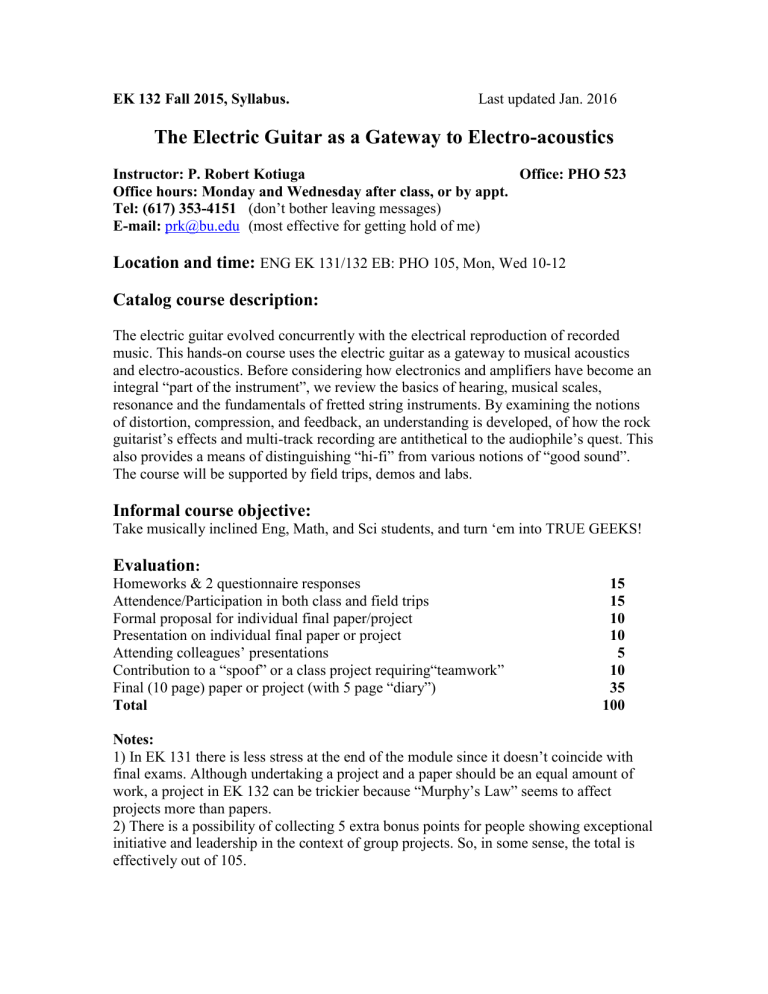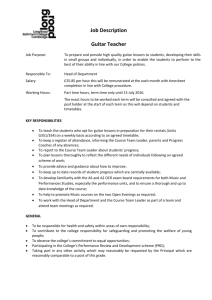The Electric Guitar as a Gateway to Electro-acoustics

EK 132 Fall 2015, Syllabus. Last updated Jan. 2016
The Electric Guitar as a Gateway to Electro-acoustics
Instructor: P. Robert Kotiuga Office: PHO 523
Office hours: Monday and Wednesday after class, or by appt.
Tel: (617) 353-4151
(don’t bother leaving messages)
E-mail: prk@bu.edu
(most effective for getting hold of me)
Location and time:
ENG EK 131/132 EB: PHO 105, Mon, Wed 10-12
Catalog course description:
The electric guitar evolved concurrently with the electrical reproduction of recorded music. This hands-on course uses the electric guitar as a gateway to musical acoustics and electro-acoustics. Before considering how electronics and amplifiers have become an integral “part of the instrument”, we review the basics of hearing, musical scales, resonance and the fundamentals of fretted string instruments. By examining the notions of distortion, compression, and feedback, an understanding is developed, of how the rock guitarist’s effects and multi-track recording are antithetical to the audiophile’s quest. This also provides a means of distinguishing “hi-fi” from various notions of “good sound”.
The course will be supported by field trips, demos and labs.
Informal course objective:
Take musically inclined Eng, Math, and Sci students, and turn ‘em into TRUE GEEKS!
Evaluation
:
Homeworks & 2 questionnaire responses
Attendence/Participation in both class and field trips
Formal proposal for individual final paper/project
Presentation on individual final paper or project
Attending colleagues’ presentations
Contribution to a “spoof” or a class project requiring“teamwork”
Final (10 page) paper or project
(with 5 page “diary”)
Total
15
15
10
10
5
10
35
100
Notes:
1) In EK 131 there is less stress at the end of the module since it doesn’t coincide with final exams. Although undertaking a project and a paper should be an equal amount of work, a project in EK 132 can be trickier because “Murphy’s Law” seems to affect projects more than papers.
2) There is a possibility of collecting 5 extra bonus points for people showing exceptional initiative and leadership in the context of group projects. So, in some sense, the total is effectively out of 105.
Required text:
Sir James Jeans "Science and Music," Dover Publications, 1968, ISBN 9780486619644.
This book is a masterful popular exposition written by a leading scientist, in the 1930s (!) when electroacoustics was an exploding field. (Although the telephone and radio were established technologies in the 30s, talkies, TV, tape recording, electric musical instruments, and sonar were rapidly driving technological improvements). Although some physiological aspects are dated, the book teems with very concrete explanations.
This is the only required text. Enjoy it! Numerous other books and online resources will be suggested on an “as needed basis”, but two favorites are …
(Totally optional) References (depending on your interests):
Daniel Levitin
, “This is Your Brain on Music; the science of a human obsession”,
Plume books (Penguin Group) 2007, ISBN 978-0-452-28852-2
… In the last 20 years functional MRI (fMRI) has revolutionized how we understand the brain. In particular, it has enabled us to understand our passion for music in terms of medical imaging. This NYT best-seller brought these advances to the general public.
Ralph Denyer
, “The Guitar Handbook” 12 th
printing, ?th Ed., Alfred Knopf, New York,
2006. ISBN 0-679-74275-1. Copyright :1982 and 1992 Dorling Kindersley.
… Although electric guitar enthusiasts might go through the entire book, lecture material and projects only touch on a relatively small part of this book. See pages:
- 49-59 of “Electric Guitars”,
- 182-196 of “Guitar Maintenance and Customizing” and, as required,
-198-224 “Performance Technology”
… In general, for electric guitars I urge you to use online resources.
“Past and Potential” Field Trips:
*The Guitar Center Jan 22 nd
*Boston MFA: Stringed instruments collection Jan 29 th
*BU COE Labs (beyond the Imagineering Lab):
ECE: “Circuits and electronics”
(PHO 105)
BME: hearing research.
*John R. Silber Symphonic Organ in GSU,
*Local store catering to audiophiles; Spearit Sound, now Audio Concepts, or
Goodwins High End (in Waltham).
…and depending on the class interest…
*A facility for recording and archiving music; for example the BU’s Mugar Library
Music Collection, Harvard Music Library, BU’s CFA, or a local FM station with facilities for live recording, such as WGBH or WBUR.
*Boston Symphony Hall: for acoustics and recording facilities
*Mix-One Studios; one of New England’s premiere recording studios
*Berklee College of Music; Music Production &Engineering dept.
Our favorite videos/documentaries:
« Tom Dowd and the Language of Music », 2003
… a film by Mark Moorman
« The Music Instinct : Science and Song », 2009
… a film by Elena Mannes & hosted by Bobby McFerrin and Daniel
Levitin…this movie was inspired by Daniel Levitin’s book and the director has a
2011 follow-up book called : « The Power of Music »
« Touch the Sound; a Sound Journey with Evelyn Glennie »
Restoration Stories; The BU Symphonic Organ. (Also in Bostonia and BU Today).
Overview of Syllabus Topics:
Cosonance, dissonance and musical scales
The decibel scale, log frequency scale, the idea of a Bode plot
“String theory for Engineers and Musicians”…
The Electric Guitar ; pickups and speakers
Acoustic resonance, cavities and transmission lines
Amplifiers, distortion, music reproduction, compression of dynamics
Music recording and (re)production: “Good Sound” vs. “Hi Fi”,
Hearing, music and the brain
Possible labs and class demos
:
Difference between chromatic and well-tempered scales illustrated via “beats”
Signal generators, Lissajous figures, oscilloscopes, and beats.
Harmonics on strings and spectrum analysis.
The circle of fifths and the circular slide rule. (Tom Toffoli inspired).
Experiments with coupled and/or electromagnetically driven tuning forks; resonance.
Equations involving string density, length, tension, and oscillation frequency.
Speed of sound, phase response, feedback and (in)stability
Room acoustics
The decibel scale and Bode plots.
Guitar effects pedals, distortion circuits (depending on student interest).
Ties to engineering software: Matlab, Simullink, LabView.

